Imagine that every one of the 310,989,947 Americans — even babies, fat people, and the frail elderly — weighed exactly the same for statistical purposes.
Make that every one of the 310,989,955 Americans. The number ticks inexorably upward and will probably reach 310,990,000 before I’m through writing this, and, who knows, maybe 311,000,000 by the time you read it.
Again, imagine that each one of those 311 million people weighed the same and that you could place a little weight representing each one of them on a map in the exact spot where he or she lives. A very few of these weights, relatively speaking, will show up in remote Alaska and Hawaii, but 99.4 percent of the population — and of the little weights — would spread across the “Lower 48” states on the mainland.

Your job's not this hard. All you need to hold aloft is the Lower 48 U.S. states. (Wikipedia Commons)
Now things get trickier. You are suddenly a modern-day, and aptly named, mythical Atlas. Only you’re not holding the entire globe in your palm. You’re lifting a United States map with all of those equal weights in place, and balancing delicately on a pointed fulcrum.
Geographers describe the precise point, where the weight of the U.S. population (save for Alaska and Hawaii’s) is equally distributed in every direction, as the “mean center of population.” No matter which direction you’d go from that point, you’d bump into an identical number of people.
And in a week or so, the U.S. Census Bureau will announce a fascinating turn of events regarding this “mean center.” It’s strictly a statistical term. The people at this population center point are no meaner, or friendlier, than other Americans. At least I wouldn’t think so.
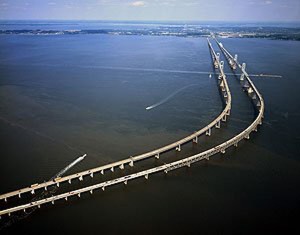
When the first U.S. Census was conducted in 1790, the nation's mean population center was very near the Chesapeake Bay, minus this modern bridge, of course. (Carol M. Highsmith)
When the population point was calculated following the first decennial census in 1790, it lay just outside Baltimore, Maryland. Those were the days, three years after the nation had been officially founded with the adoption of the U.S. Constitution, when most Americans lived along the Eastern Seaboard, and all 13 states were located there.
That year President George Washington — a farmer and former soldier who presumably was in pretty good shape — could have hiked the 54 kilometers (34 miles) or so from the White House up to the geographical center of the United States in one long, strenuous day, or two for sure.
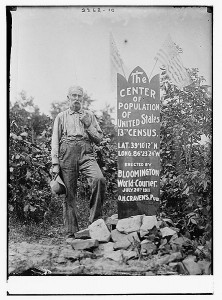
By 1910, the nation's population center had moved all the way west to the environs of Bloomington, Indiana. (Library of Congress)
Today our physically fit president, Barack Obama — and an immense security detail, would have quite a hike ahead of them to the mean center of the nation. It is expected to have moved 1,300 kilometers (about 800 miles) away, to Texas County, Missouri, since Washington’s time.
But it’s not just the distance from the East Coast that our population center has been moving that’s of note. It’s the direction.
As you see on the Census Bureau map below (be sure to click on it and blow it up), the population core moved almost straight west for 160 years from 1790 to 1950, reflecting the westward tug of the nation’s migration.
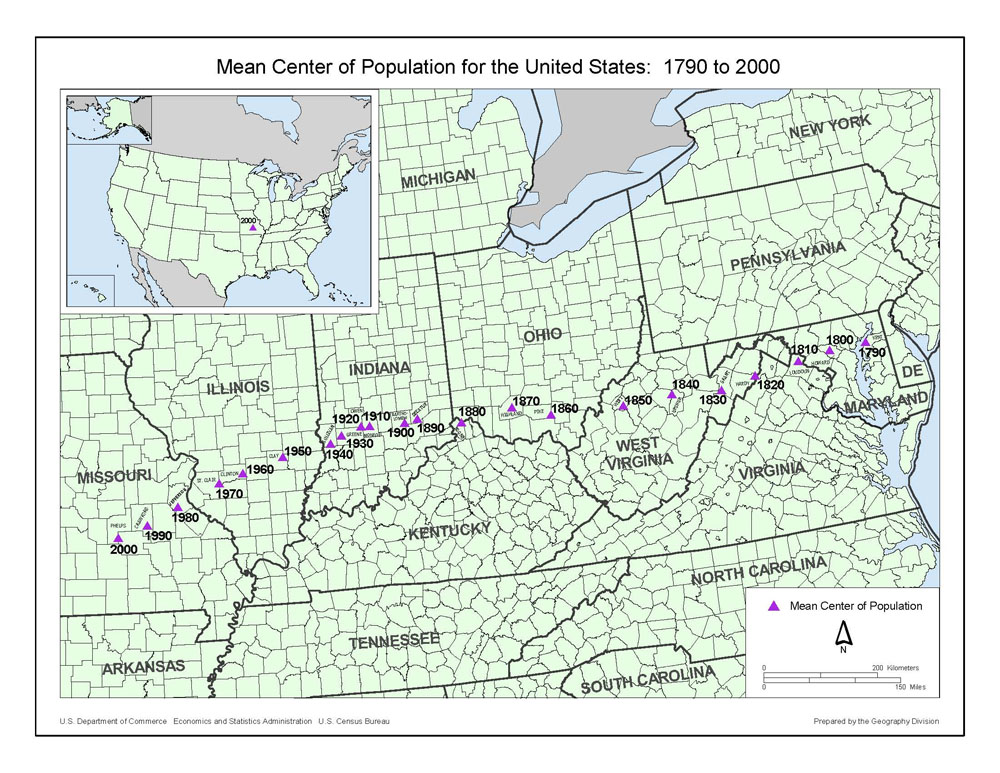
The center of the nation's population had reached central Missouri by 2000. It will soon be announced as having moved even farther to the south and west. (U.S. Census Bureau)
The mean center crossed the Mississippi River into Missouri in the 1970s, and began turning south and westward for the first time as well. This occurred as the southwestern “Sun Belt” was stepping up its efforts to lure hundreds of thousands of Americans away from decaying North and Northeast “Rust Belt” towns.
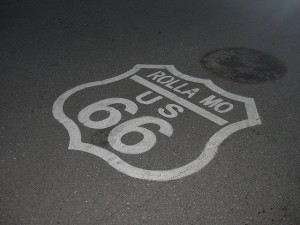
We associate historic U.S. Route 66 with the American heartland. And the nation's population mean center is already past this pavement sign near Rolla, Missouri. (jimmywayne, Flickr Creative Commons)
In 2000, the nation’s population midpoint reached Phelps County, Missouri. And if you look at the inset map of the entire country, you’ll see that this put it within shouting distance of the actual, geographic center of the Lower 48 states as well. More about it in awhile.
2010 Census results are expected to show an even more dramatic population turn toward the southwest, fittingly into that Missouri county called “Texas.”
If this course continues as expected, the mean center of the nation — “Middle America” — figures to keep on going, leaving the Midwest entirely for either the southern state of Arkansas or the southwestern state of Oklahoma by the middle of the century.
And it will carry enormous implications with it.
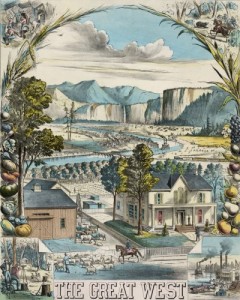
“The West [is] beginning to emerge as America’s new heartland,” Robert Lang, a sociologist at the University of Nevada-Las Vegas, told the Associated Press. [It also reflects] a swing point in American politics.”
The article’s author, Hope Yen, crystallized the point. In the 1960s, she pointed out, “‘Will it play in Peoria?’ was a common phrase that coincided with the U.S. center’s location [not far from Peoria] in Illinois. It was a measure of whether a politician or consumer product could appeal to mainstream Americans with traits associated with Midwesterners, such as stability and caution.”
But over the last decade, the Phoenix suburb of Peoria, Ariz., soared past its namesake Peoria, Ill., in population size. . . . With Arizona on track to surpass [the once-booming Midwest state of] Ohio in electoral votes by midcentury, issues important to the West, such as Arizona’s sharp debate over immigration, gain in political significance.
So will other matters of particular interest to Southwesterners: water, access to minerals and timber and grass on the region’s vast federal lands, and health care for the elderly. Millions of elderly Americans decamped from the cold North years ago, forcing Sun Belt states to figure out how to care for this legion of retirees.
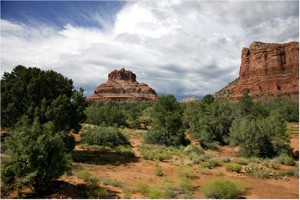
Arizona is starkly beautiful but also forbidding. Yet it and surrounding Southwest states are magnets for migrating Americans. (Carol M. Highsmith)
Surely the lurch toward the southwest of America’s population cannot continue indefinitely. After all, how many people can places like West Texas, New Mexico, and Arizona — deserts all, in the main — support?
Yet the surging growth in the region’s Latino population has exceeded Census Bureau estimates, and the West as a whole grew by almost 14 percent to nearly 72 million people since the last census, pushing it ahead of the Midwest into second place behind only the Northeast.
Now I should point out something obvious.
While the population is shifting ever southwestward, the geographic center of the lower 48 states isn’t going anywhere! I know. I’ve been there.
Leaving out far-off Alaska and Hawaii, the precise physical center of the 48 states that form the U.S lies just outside the tiny town of Lebanon, Kansas, the state to the immediate west of Missouri.
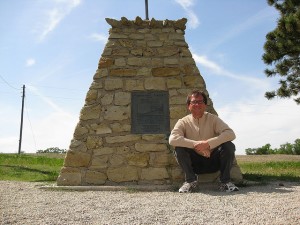
I found America’s “centroid,” as scientists call it, in a field of milo, a feed grain also used to make synthetic gasoline called ethanol. Using satellite technology, the U.S. Geological Survey calculated that this spot at 39’50” north latitude and 98’35” west longitude was the exact geographic center of the traditional United States.
But unlike the booming Sun Belt towns toward which the nation’s population is migrating, Lebanon could be the test case for “dying rural America.” It has steadily lost population, lost its high school, grade school, car dealership, and community hall where movies were once shown.
Its 2010 population of 252 was down 51 people — 17 percent — from the year 2000.
Peoria, Arizona’s, population, in sharp contrast, hit 154,065 last year, up 45,701 — 42 percent — over 2000. It is the fifth-fastest-growing city in America.
But at least struggling Lebanon, Kansas, will always be the midpoint of the main United States, barring something cataclysmic or the abandonment of Lebanon altogether.
And Lebanon is even the nation’s center of gravity! At least by one test.
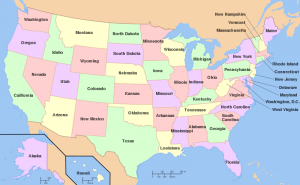
Imagine this glued to a piece of cardboard, cut out around the nation's edges, and balanced on the point of a very big pin. (Wikipedia Commons)
Before the days of global positioning satellites, topographers in Washington, D.C., took a map of the United States and overlaid it onto a thick piece of cardboard of uniform thickness. They carefully cut out an outline of the United States. Then they hoisted the cardboard cut-out onto a pointed piece of metal and kept moving the point around until the United States of America balanced!
That point was right next to little Lebanon, Kansas. Amazingly, computer studies years later confirmed that spot as the geographical center of America.
With care, I think my colleagues and I could duplicate that little experiment and probably end up with the balance point beneath Lebanon all over again.
As for duplicating the computers’ work in finding Texas County, Missouri, as our new population center by balancing — let’s see — 310,990,720 equal weights on a map? I’d need the titan Atlas to pull that one off.
Ted's Wild Words
These are a few words from this posting that you may not know. Each time, I'll tell you a little about them and also place them into a cumulative archive of "Ted's Wild Words" in the right-hand column of the home page. Just click on it there, and if there's another word that you'd like me to explain, just ask!
Decamp. To depart, especially suddenly or secretly.
Decennial. Once every 10 years, usually used in reference to the decennial census of the U.S. population.
Fulcrum. The pivot on which something, such as a lever, balances.
Inexorable. Relentless, unstoppable.

